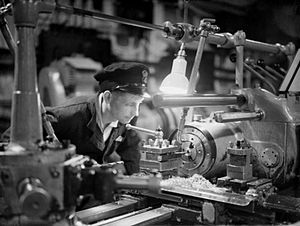
HMS Glory (R62) was a Colossus-class aircraft carrier of the British Royal Navy laid down on 27 August 1942 by Harland and Wolff at Belfast. She was launched on 27 November 1943 by Lady Cynthia Brooke, wife of the Prime Minister of Northern Ireland.
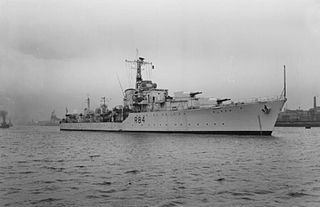
HMS Saintes was a 1942 Battle-class fleet destroyer of the Royal Navy (RN). She and 15 sister ships being ordered under the 1942 defence estimates. The ship was named after the Battle of the Saintes, a Royal Navy victory over a French fleet intending to invade Jamaica in 1782. So far she has been the only ship of the Royal Navy to bear the name. Saintes was built by Hawthorn Leslie and Company on the Tyne. The vessel was launched on 19 July 1944 and commissioned on 27 September 1946.

HMS Invincible was a Royal Navy Audacious-class ironclad battleship. She was built at the Napier shipyard and completed in 1870. Completed just 10 years after HMS Warrior, she still carried sails as well as a steam engine.

HMS Duncan was the fifth RN ship named after Admiral Adam Duncan. She was a Blackwood-class frigate of the Royal Navy that served in the Cod Wars.
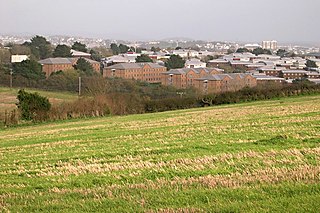
HMS Raleigh is a stone frigate, serving as the basic training facility of the Royal Navy at Torpoint, Cornwall, United Kingdom. It is spread over several square miles, and has damage control simulators and fire-fighting training facilities, as well as a permanently moored training ship, the former HMS Brecon. Its principal function is the delivery of both New Entry Training & Basic Training.
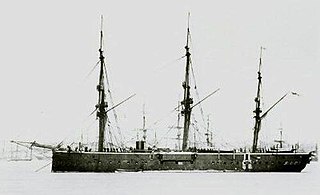
HMS Audacious was the lead ship of the Audacious-class ironclads built for the Royal Navy in the late 1860s. They were designed as second-class ironclads suitable for use on foreign stations and the ship spent the bulk of her career on the China Station. She was decommissioned in 1894 and hulked in 1902 for use as a training ship. The ship was towed to Scapa Flow after the beginning of the First World War to be used as a receiving ship and then to Rosyth after the war ended. Audacious was sold for scrap in 1929.

HMS Hercules was a central-battery ironclad of the Royal Navy in the Victorian era, and was the first warship to mount a main armament of 10-inch (250 mm) calibre guns.

The Audacious-class ironclad battleships were designed by Sir Edward Reed at the request of the Board of Admiralty to serve as second-class battleships on distant foreign stations.

HMS Sultan was a broadside ironclad of the Royal Navy of the Victorian era, who carried her main armament in a central box battery. She was named for Sultan Abdülâziz of the Ottoman Empire, who was visiting England when she was laid down. Abdülâziz cultivated good relations with the Second French Empire and the British. In 1867 he was the first Ottoman sultan to visit Western Europe; his trip included a visit to England, where he was made a Knight of the Garter by Queen Victoria and shown a Royal Navy Fleet Review, with Isma'il Pasha of Egypt.
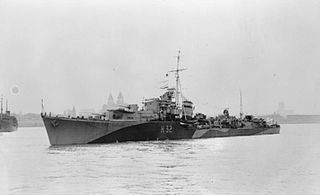
HMS Rapid was an R-class destroyer of the Royal Navy that saw service during the Second World War and was sunk as a target in 1981.
Five ships and three shore establishments of the Royal Navy have borne the name HMS Caledonia after the Latin name for Scotland:
Four ships and three shore establishments of the Royal Navy have been named HMS Sultan.

HMS Hindostan was an 80-gun two-deck second rate ship of the line of the Royal Navy, launched on 2 August 1841. Her design was based on an enlarged version of the lines of Repulse.
Three ships and a shore establishment of the Royal Navy have been named HMS Fisgard or HMS Fishguard after the coastal town of Fishguard in Pembrokeshire, Wales, the scene of the defeat of the last invasion attempt on Britain, by a French force in 1797 during the French Revolutionary Wars.

HMS Fisgard was a 46-gun fifth rate Leda-class frigate of the Royal Navy. She spent sixty years in service on a variety of duties.

HMS Artifex was a repair ship of the Royal Navy from late in the Second World War and into the Cold War. Launched as the Cunard liner RMS Aurania she was requisitioned on the outbreak of war to serve as an armed merchant cruiser. Damaged by a U-boat while sailing with an Atlantic convoy, she was purchased outright and converted to a floating workshop, spending the rest of her life as a support ship for the navy.

Engine room artificer (ERA) is a specialised position in the crews of naval vessels – especially those of the British Royal Navy (RN) and other Commonwealth navies. An ERA is usually a fitter and turner, boilermaker, coppersmith or enginesmith. On larger vessels, there are several ERAs, divided into three or more classes. Each of these positions is normally associated with a specific non-commissioned rank and level of experience – for example, an ERA is normally a Chief Petty Officer (CPO). The designation ERA was introduced in the early days of steam-powered warships, and in most navies is now obsolete.
Ministry of Defence Caledonia is a military establishment of the Ministry of Defence based at the former Royal Naval Dockyard, Rosyth in Scotland.
